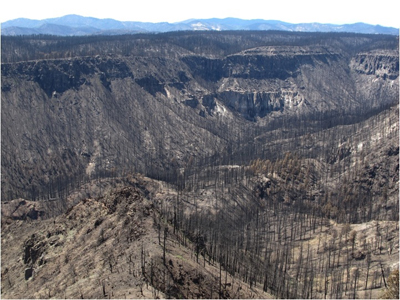Posted 2:34 p.m. Friday, April 20, 2012

 [/caption]If global climate change predictions are correct, forests in southwestern United States will look a lot different in the next 50 years. Expect more bark beetle outbreaks and wild fires blazing through the greens, says Park Williams, a researcher from Los Alamos National Laboratory in New Mexico.
Williams will share his study of how global climate change will affect forests at 4 p.m. Thursday, April 26, in 1400 Centennial Hall.
Williams analyzed tree rings in more than 14,000 trees in southwestern United States and compared tree-ring widths to 117 years of climate data. His results show that evaporation rates are just as important as the amount of rainfall in determining the severity of forest drought stress in the Southwest. Forests become more stressed when precipitation decreases or when evaporation increases.
“The fact that evaporation rates are so important to forest health is interesting because we know that evaporation will increase in the future as temperature increases,” he notes.
If climate change occurs as expected, he predicts that average year-to-year levels of forest drought stress by 2050 will match or even exceed those of the infamous megadroughts of the 1200s or 1500s in the Southwest.
Those megadroughts caused widespread forest dieoff. The 1200s drought was a likely driver of the abandonments of cultural centers such as Mesa Verde and Chaco Canyon. Williams’ study and his forecast of an imminent increase in forest drought stress in the Southwest has implications for how people manage forests and water resources now and in the future, he says. The finding that temperature and evaporation rates are just as important as precipitation in dictating forest health and vulnerability to dieoff may apply to forests beyond the Southwest, he says.
UW-L's Department of Geography and Earth Science is hosting Williams.
[/caption]If global climate change predictions are correct, forests in southwestern United States will look a lot different in the next 50 years. Expect more bark beetle outbreaks and wild fires blazing through the greens, says Park Williams, a researcher from Los Alamos National Laboratory in New Mexico.
Williams will share his study of how global climate change will affect forests at 4 p.m. Thursday, April 26, in 1400 Centennial Hall.
Williams analyzed tree rings in more than 14,000 trees in southwestern United States and compared tree-ring widths to 117 years of climate data. His results show that evaporation rates are just as important as the amount of rainfall in determining the severity of forest drought stress in the Southwest. Forests become more stressed when precipitation decreases or when evaporation increases.
“The fact that evaporation rates are so important to forest health is interesting because we know that evaporation will increase in the future as temperature increases,” he notes.
If climate change occurs as expected, he predicts that average year-to-year levels of forest drought stress by 2050 will match or even exceed those of the infamous megadroughts of the 1200s or 1500s in the Southwest.
Those megadroughts caused widespread forest dieoff. The 1200s drought was a likely driver of the abandonments of cultural centers such as Mesa Verde and Chaco Canyon. Williams’ study and his forecast of an imminent increase in forest drought stress in the Southwest has implications for how people manage forests and water resources now and in the future, he says. The finding that temperature and evaporation rates are just as important as precipitation in dictating forest health and vulnerability to dieoff may apply to forests beyond the Southwest, he says.
UW-L's Department of Geography and Earth Science is hosting Williams.